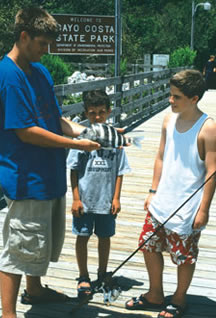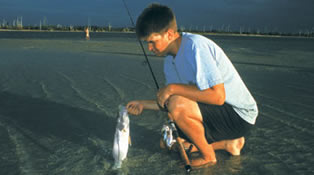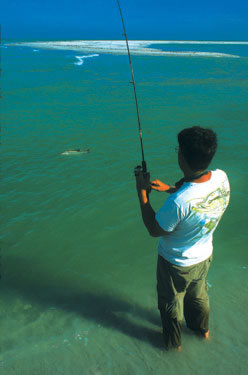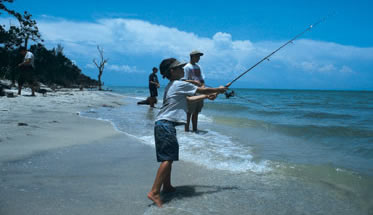October 01, 2005
By Tom Levine
Snook fishers return to a dreamy island hideaway.

Park visitors catch sheepshead on the pier. |
Sleepless for days we sluiced our tan feet through the white sand shallows of a moonsilver saltwater stream, rejoicing in this mosquito-free cool breeze corridor and heatless light blasting from a white hole in space. If we lived on the island, sleep might seem a reasonable option; but for a five-day hiatus in snook fishing paradise, we foresook dreams to stalk our quarry amidst the stark, colorless images of the full moon.
Hoping for comfortable
camping on Cayo Costa in June is rolling the dice when you need boxcars. That time optimism was rewarded in a way we never expected. Who knew we would avoid the discomfort of attempting sleep in still night with heat, mosquitoes and no-see-ums by simply skipping it?
Eight months after Cayo Costa was Florida's first line of defense against 170 mile per hour winds, we returned. Looking for hard evidence of our experience, we couldn't find it. Hurricane Charley had moved the inlet a quarter mile down the beach and blew that stream to the land of memories. All I have is my last remaining Salty Cisco, incredible snook lure, relic from Cisco Kid of Boca Raton, rear treble hook pulled out by a monster that dragged me a hundred yards downstream to the lagoon, where it dipped beyond the delta and broke my heart
Off Pine Island Sound, Cayo Costa State Park has exactly what is needed for relative comfort, survival and nothing more. Rescued from the mainland by Boca Grande Pass, it's the ideal Florida location to get that good ol' shipwrecked feeling: no phone, no 'lectric, no bridge. Just campsites or twelve three-bunk cabins built during the New Deal. The luxuries are cool showers, drinking water and a place to clean your fish.
The cabins don't cost much more than the tent sites and they have six beds so we always get a cabin. Before the hurricane each little house sat under giant Australian pines, as in a subtropical paradise, separated from the others by the tall, curtain-like trees. The campsites were in a similar setting, hardly noticeable. Now as we reached the camping area on the cross-island tram, it was shocking to see the weekend campers who waited for their ride back to the ferry dock like refugees from a storm, standing by their baggage in a wide, open space with only the broad stumps of trees reminding them of the shade that once had been.
The cabin area was equally changed, trees gone, the cabins lined up like migrant labor quarters or a rough-hewn fish camp from the past. But like my ten year old Ely said, “Who cares? We're here for the fishing.” He'd already caught a 15-inch snook while waiting for the ferry on the Pine Island side.

Wading offers good shots at snook. |
After unloading our three coolers of ice, too many bags of bagels and soft-oatmeal bread and everything else at cabin number 11, my two boys and I struck off on the trail to the northern point of the island, where we had really gotten into snook before. We walked through scrub forest, after 20 minutes emerging on an uninhabited beach in a brilliantly lit world painted only with lime green, blue and white for the scattered clouds. We strolled along in the light breeze casting, me a rubber jig, Ely a 1/4-ounce spoon and Sam a bucktail. Nothing was happening, then Ely screamed and I saw him struggling to hold onto his ultralight spinning rod, drag pouring out like nonsense from a congressman's mouth. He'd never felt a fish like that before and feared being spooled, so he was trying to slow the line's departure with his hand. In a moment his head was down as he listlessly walked back up on shore, kinked line hanging loosely from his rod, saying quietly, “Life isn't worth living anymore.”
Knowing this fisherman as I do, that was more poignant than any amount of ranting and raving. I knew it would be true until he hooked and landed something pretty good. We were in the right place for that. Returning by the beach a little later, new spoon on, he caught a jack and the healing began.

Hurricane Charley plowed this fishy cut. |
The cabins are situated halfway between the north end and the lagoon inlet, our two main fishing spots. Our evening stroll to the inlet was a bit longer because the cut was farther and all it was was a cut, a gash joining Gulf and lagoon, 30 feet wide, 50 yards long; but worth it when we got there. At the bottom of an outgoing tide, mullet were piled up on the lagoon side, getting busted, no one there but us. Used to casting purely on faith that a fish might be around, the boys were stunned by this opportunity, never having seen its like and suspecting I never had either. Sam caught a snook and a jack, both of which shot down the cut with him in hot pursuit. The jack he passed, the snook he couldn't. The pattern for the trip was set: random moments of glory for all, usually arriving with that element of surprise that separates lightning from the lightning bug.
The fishing is a marvelous combination of great and easy. Anybody who can cast an artificial lure will find exciting potential just off the beach, at the pass or the lovely lagoon a half hour walk from the cabins. We live on snook, flounder and seatrout on the island, this pure diet a probable boon to our biology. Most of the flour-based food made it back to the mainland intact. Boca Grande Pass is famous for the fabulously exciting tarpon and plenty of them wander over to Cayo, providing a wild and sometimes unexpected thrill for an angler. The simplicity of it all feels very fine and natural.
We left a canoe at the dock for when we weren't splashing around in the shallow current of the lagoon inlet, snorkeling, hunting buried treasure or fishing near our wee house. It's a fairly long paddle from there to the Manatee Hole, a deep cove off Pelican Bay featuring a spring that attracts hordes of the friendly mermaids in the cool months. North America's largest mollusk, the horse conch is common in the shallows along with many other beautiful shellfish and live sand dollars high and dry, black as the tar on California beaches. The boys returned the dollars to the Gulf to spare them concern about the tide not rising. One evening, returning from the inlet, we chanced upon a sea turtle laying her eggs.
As always, when you go to the sea for adventure, you see amazing things. On
e morning just after dawn, we were casting into the gently lapping waves when Sam yelled “Look at that!”
Ely and I looked and it happened again, so startling and odd that I just yelled something like, “Whoaowww!” Imagine you're standing there fishing and one hundred feet to your left and the same distance out, a black whale shoots straight up so its tail is 10 feet off the surface. That's what it looked like to us. It actually was an enormous dark dolphin that had grabbed a fisherman's fish and halfway spooled him.

Kids can't help but have fun here. |
Sam switched to a fancy bucktail which took charge of the morning, getting him three snook, three jacks, a Spanish mackerel and a whiting. Ely's spoon got him snook, jacks and a Spanish. I was getting only jealous until next to a sandbar our first keeper snook smashed my rubber jig five feet from shore, shaking his big mouth out of the water before dragging me and my 6-pound line around for a half hour. As we returned to the cabin, a woman asked me if we had seen any pigs on the beach. I found it a surprising question and didn't really know how to respond. Well, that evening, there it was—a big black pig rooting on the beach.
That evening we were heading for the cut but found every baitfish packed into the back of the lagoon by every predator. First cast Ely got an 18-inch snook on his spoon, Sam got a jack on his bucktail and I broke out my new fly outfit, tossing a white streamer. I haven't done much saltwater fly fishing so when I felt a powerful pull on my streamer, I was excited. The 9-foot rod developed a deep bow and the line was leaving. So they could share the significance, I yelled over my shoulder to the boys, “This is the first decent saltwater fish I've ever gotten on fly rod.” That got them all exuberant and I'm still convinced I had been fighting a large snook up until I said that and it turned into the butt-hooked mullet I eventually landed.

Seatrout bite well after dark. |
As we reached the cabin area that night, more of a social setting with the trees gone, it struck me how unique the place was, people reclining on the porches, small fires going, talking about fishing under a sky full of fiery stars, nary a radio intruding on our escape from a diet of sensory garbage. Some of the folks were aged and I got the feeling they'd been sitting there off and on before I was born, digesting the great ancestors of the fish we'd caught. Somehow it seemed just exactly right.
Waiting for the ferry we catch some of our best fish off the dock and this time Sam got two giant flounders and Ely a small snook. Ten-year-old Ely only tolerates life between visits to Cayo Costa and he can't stand for it to end, so he was fishing as the ferry loaded. He was granted a final dose of glory, battling some big fish from under the dock until it tragically slipped the hook. Was his whole trip ruined? You bet it was. This time it will be a while before he comes right.
GETTING THERE
Ferry Service: You can take the Tropic Star ferry service from Pine Island, for $30 per person, plus $8 per night per parked vehicle. Phone (239) 283-0015. Smaller boats also will run people out from Boca Grande.
Local Boat Ramps:
Placida, Eldred's Marina (941) 697-1431
Bokeelia, Harbor Hideaway (941) 283-1167
Advertisement
Bokeelia, Mattson Marina (941) 283-4334
Habitation:
- 12 primitive cabins with screen windows, three bunks with mattresses, outdoor grill, indoor and outdoor picnic tables. Cost $30 per night for up to six people; maximum stay two weeks.
- 25 tent sites: $18 per night up to 8 people. Restrooms with cool showers and wash tubs available. Ranger station with ice for sale $2 per bag. Must bring all supplies.
Advertisement
- Tram: one ride from dock to cabin, one ride back.
- Dock for mariners to tie up vessels.
What to Do: Fish, swim, hike, star gaze, paddle, feel disconnected from the grid.
Ferry will transport canoes and kayaks to island. Good to bring dolly to roll canoe across island. Rangers will not carry them on tram. They can be left for use at dock or paddled a few miles to lagoon or cabin beach. Man powered craft is ideal for fishing the lagoon
Seasons: Fall through spring, like anyplace in Florida, delightful. Summer comfort depends a lot on the whimsy of no-see-ums and skeeters, whose presence is magnified by rain. Bicycles are handy.
What Fish are There When: Tarpon mid April through July in passes and on beach. Pompano best in cooler months. King and Spanish mackerel, same as tarpon, Spanish in close, kings a mile or so off. Flounder all year, concentrated in October, November. Seatrout all year. Cobia September, October, when stingrays show up. Sheepshead perennial, good among rocks at north end. Snook spring through fall best.
Tackle: Most useful is typical bass tackle; one light rod with 6-pound test for light jigs, one medium outfit with 8-pound for snook; can get away with light tackle due to scarcity of obstructions. Jigheads with small tube lures will catch everything. For big tarpon, large reel with 250 yards capacity 15-pound test, 60-pound mono leader. Plugs, spoons and jigs good for snook and tarpon at night. Clouser Minnow and streamers good for fly fishing.
Bring: Cast net, bug repellent, mosquito coils, food, more than one cooler full of ice, cell phone (not), source of light, cooking fuel, full moon, marshmallows.
FS

